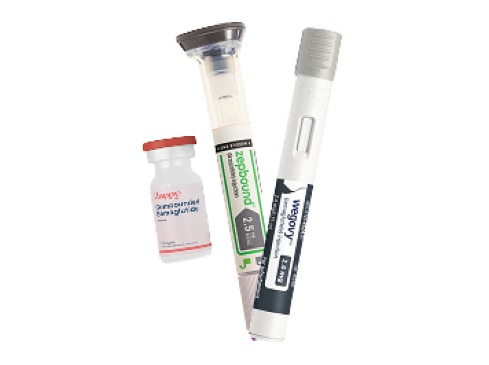Traveling with semaglutide or tizerpatide, a medication often used to treat type 2 diabetes and obesity, requires special care to ensure it remains effective. Does compounded semaglutide need to be refrigerated? Yes, before first use, keep semaglutide or tizerpatide refrigerated. After opening, it can be stored in the fridge or at room temperature. When traveling, avoid extreme temperatures by storing semaglutide in an insulated travel case, away from sunlight and heat. Keep it in your carry-on for air travel, and in your car’s main body if driving. Consistency is key—maintain your dosing schedule, even when crossing time zones. Consult your healthcare provider for tailored advice and always check destination rules if traveling internationally.
Storing Semaglutide or Tirzepatide Safely while travelling
Semaglutide must be kept in the refrigerator before first use to ensure its effectiveness. Store it at a temperature between 36°F to 46°F. Avoid placing it in the freezer. If accidentally frozen, do not use it and consult your healthcare provider for guidance.
After initially using semaglutide, it can be stored at room temperature, but this should not exceed 86°F. If traveling, use insulated bags with ice packs to maintain the correct temperature. Remember to check the temperature regularly to avoid any extremes that could compromise the medication.
Protect semaglutide from direct sunlight and excessive heat to prevent it from degrading. Always keep it in its original packaging when possible, as this can offer additional protection. If you are in a hot climate, ensure the storage area is cool and shaded.
- Refrigerate the medication until first use.
- Store at a temperature between 36°F and 46°F (2°C and 8°C) before first use.
- After opening, store at a room temperature not exceeding 86°F (30°C).
- Do not freeze.
- Avoid storing in direct sunlight or extreme heat sources.
- Check expiry date before use.
- Follow specific storage instructions provided by your healthcare provider.
Semaglutide and Tirzepatide when traveling by Air or Train
When traveling with semaglutide, it’s crucial to keep the medication in your carry-on luggage. Checked luggage can be exposed to extreme temperatures and rough handling, which could compromise the effectiveness of the drug. By keeping semaglutide with you, you can also ensure it stays at the correct temperature and remains secure throughout your journey.
Using an insulated travel case is a smart way to keep semaglutide at the recommended temperature range while traveling. These cases are designed to maintain a stable internal temperature, protecting your medication from external heat or cold. Look for a case that includes gel packs or other cooling mechanisms that can be easily re-frozen or replaced along your trip. Reliable temperature control is essential for preserving the medication’s potency.
When traveling by air, it’s important to be aware of and comply with airline regulations regarding medication. Inform the security officers that you are carrying semaglutide, and be prepared to present a prescription or doctor’s note if requested. Most airlines allow you to bring medications in your carry-on, but it’s best to check specific guidelines in advance. Ensure that the medication is clearly labeled with your prescription details to avoid any unnecessary delays or complications at security checkpoints.
| Method | Reason |
|---|---|
| Keeping Semaglutide in Carry-On Luggage | Avoids potential delays and exposure to extreme temperatures in checked luggage |
| Using Insulated Travel Cases | Maintains the medication at the correct temperature during transit |
| Complying with Airline Regulations | Ensures smooth passage through security and customs checks |
Traveling by Car with GLP1-medication
When traveling with semaglutide by car, it’s crucial to store it in the main body of the vehicle rather than the trunk or glove box. These areas can experience extreme temperatures, which could compromise the medication’s effectiveness. Keeping semaglutide in the cabin ensures it stays within a safe temperature range.
Additionally, using an insulated bag with cooling packs is a good method to maintain the proper temperature for your semaglutide. These bags are designed to provide a stable environment and can prevent the medication from getting too warm or cold. It’s a simple yet effective solution to protect your medication while on the road.
Avoid placing semaglutide in the trunk or glove box at all costs. The temperature in these areas can fluctuate drastically, especially during periods of extended travel or when parked for long periods. By keeping it in the main body of your car and using appropriate storage measures, you can travel confidently, knowing your medication is safe.
Crossing Time Zones
Maintaining a consistent schedule is crucial when traveling with semaglutide. Regardless of where you are, make sure to take your medication at the same time each day. Use your smartphone to set daily reminders, adjusting for the local time zone if necessary. Keeping a regular schedule can help you avoid missing doses or accidentally taking an extra one.
Adjusting for different time zones can be tricky, but planning ahead can make this easier. Before you leave, calculate the time difference between your departure and destination points. If there’s a significant time gap, gradually shift your medication schedule a few days before your trip. This gradual adjustment will help your body adapt to the new time zone without disrupting your treatment routine.
Consulting your healthcare provider before traveling is always a good idea. They can provide specific recommendations on how to manage your medication schedule when crossing multiple time zones. Your provider may also offer tips on how to store semaglutide while traveling, ensuring it stays effective. Having a travel plan in place can make your journey smoother and keep your treatment on track.
International Travel Considerations with Semaglutide and Tirzepatide
Before embarking on international travel, it’s crucial to check the regulations of your destination concerning semaglutide. Some countries have strict rules about bringing medications, and you might need to obtain special permits or provide a prescription. Researching these rules in advance can help avoid any legal issues or delays at customs.
Always carry your semaglutide in its original packaging. This helps officials identify the medication accurately and ensures that all important labels, such as dosage information and expiration dates, are clearly visible. Pharmacies typically provide medications with labels that include your name as well, which can prove the medication is for your personal use.
Bringing necessary documentation is key when traveling internationally with semaglutide. Obtain a letter from your doctor explaining your need for the medication and include a copy of your prescription. This documentation can be helpful if you are questioned by customs officials or if there are any issues with medication verification.
Managing Your Health on Vacation when you are on semaglutide or tirzepatide medication
When you’re on vacation, it’s important not to skip your semaglutide medication. Missing doses can lead to unstable blood sugar levels, which can ruin your trip and compromise your health. Always plan ahead by packing enough medication for the entire duration of your stay, plus a few extra days in case of travel delays. Carry your medication in a cooler bag if it needs to be kept at a specific temperature.
Regularly monitoring your blood sugar levels while traveling helps you stay on top of your health. Changes in diet, activity levels, and time zones can affect your blood sugar. Keep a log of your readings and any symptoms you experience. This will help you make informed decisions about your meals and activities during your trip.
Keeping in frequent contact with your healthcare provider is crucial when traveling with semaglutide. Inform them of your travel plans and ask for any specific advice or adjustments needed for your medication. Having open communication ensures you can get support quickly if any issues arise, such as side effects or fluctuations in your blood sugar levels.
TL;DR Learn how to travel with Semaglutide safely by properly storing and handling it. Before first use, keep it refrigerated; once opened, maintain the manufacturer’s temperature guidelines, avoiding direct sunlight and excessive heat. For air or train travel, keep Semaglutide in your carry-on, use insulated travel cases, and comply with airline regulations. When traveling by car, store it in the main body of the vehicle using insulated bags with cooling packs. Avoid leaving it in the trunk or glove box. To manage crossing time zones, maintain a consistent schedule, adjust dosing times, and consult your healthcare provider. For international travel, check destination regulations, carry medication in its original packaging, and bring necessary documentation. Don’t skip doses, monitor blood sugar regularly, and stay in touch with your healthcare provider.
Frequently Asked Questions
1. Can I bring Semaglutide on an airplane?
Yes, you can bring Semaglutide on an airplane. Keep it in its original packaging and place it in your carry-on bag to avoid temperature fluctuations in checked luggage.
2. How should I store Semaglutide while traveling?
Semaglutide should be stored in a cool place. Use a small insulated bag with ice packs to keep it refrigerated while you’re on the go.
3. Do I need to inform airport security about my Semaglutide?
Yes, it’s a good idea to inform airport security that you are carrying Semaglutide. They might ask to see your prescription, so have it handy.
4. What if my Semaglutide gets too warm during travel?
If Semaglutide gets too warm, it may lose its effectiveness. If you’re unsure, contact your healthcare provider for advice.
5. How do I handle time zone changes when taking Semaglutide?
When traveling across time zones, try to take Semaglutide at the same time you usually would at home. Consult your doctor if you’re unsure about adjusting your schedule.
Yes, you can bring Semaglutide on an airplane. Keep it in its original packaging and place it in your carry-on bag to avoid temperature fluctuations in checked luggage.
Semaglutide should be stored in a cool place. Use a small insulated bag with ice packs to keep it refrigerated while you’re on the go.
Yes, it’s a good idea to inform airport security that you are carrying Semaglutide. They might ask to see your prescription, so have it handy.
If Semaglutide gets too warm, it may lose its effectiveness. If you’re unsure, contact your healthcare provider for advice.
When traveling across time zones, try to take Semaglutide at the same time you usually would at home. Consult your doctor if you’re unsure about adjusting your schedule.





